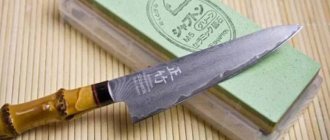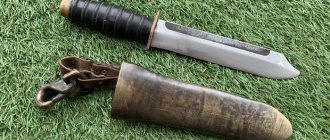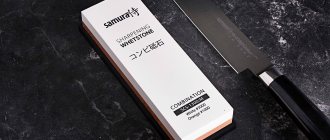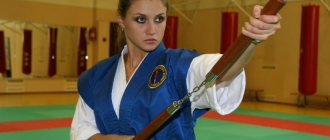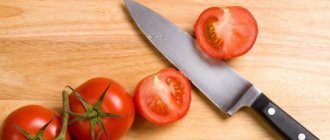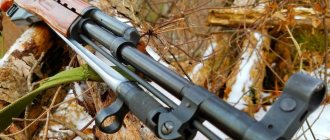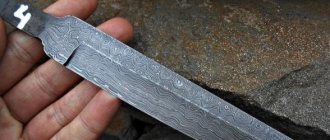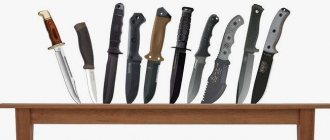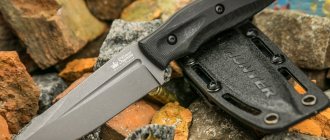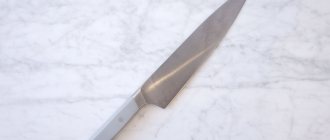Each knife, like any other tool, requires constant proper care, especially since its cutting part needs to be renewed from time to time. It’s not for nothing that people say that you can only cut yourself on a dull knife blade. What usually happens is that the dull blade breaks off from the part being cut off and tears the skin on the hand.
To avoid any accidents and careless injuries, the knife blade must be renewed periodically. We sharpen the blade to a certain angle, which depends on the purpose of the blade and varies from 15 to 45 degrees from the central point.
Sharpening features
During the manufacturing process, based on the professional goals and purpose of the tool, a certain blade shape, thickness parameters and inclination of the cutting edges are selected. It is thanks to the correct inclination of the angles and position of the blade that the most stubborn textures can be processed, since the correctness of the cut is ensured only if certain working positions of the tools are observed.
Optimal knife sharpening angles require maximum pressure on the cutting materials during operation. If the tilt changes, the blades can easily be damaged. It is important to note here that each blade model needs to be sharpened with strict adherence to certain angles. Based on what design features the knife has and what use it is intended for, the optimal sharpening angles are determined.
At the same time, it is undesirable to process some types of professional or chef’s tools (Tramontina and Lansky) yourself; this should be done by a qualified person using special equipment so as not to damage the blade.
Sharpening and editing
First, let's separate these two concepts. Sharpening is the formation of a cutting edge (CR), and editing is needed to bring this edge to working condition. At high magnification, the cutting edge of a knife sharpened on a large block looks, frankly, unimportant and resembles a rock ridge eaten away by erosion.
Editing the paint using a fine abrasive allows you to bring this visual nightmare to a more or less decent state. The knife begins not only to cut, but also to shave (if, of course, you did everything correctly).
What is the sharpening angle of a knife
Often, this value is rarely indicated in the technical specifications for a particular tool when purchasing it, although it is one of the important criteria that affects the cutting property of the tool. The lack of relevant information may cause some difficulty for the owner in understanding at what angle to subsequently sharpen the tool. To avoid this, you can use the table below for sharpening angles of knives. However, before that, let's figure out what this value actually is.
The area where the slope on the blade smoothly meets the edges of the cutting edge is called the approach. The angles of convergence of the approach on the two sides of the knife blade are called the “sharpening angle.” Ideally, the blade may have no leads; in such cases, sharpening angles are called trigger angles. But instruments with such a design can be found quite rarely. These mainly include products such as professional Japanese kitchen knives.
The sharpening angles are directly responsible for the purpose and type of work for which the knife was created. The smaller the sharpening angle, the easier it is to cut and the knife becomes sharper, but it quickly becomes dull and needs to be sharpened again. The greater the sharpening angle, the more similar the blade becomes to an ax and the longer it keeps its sharpness.
About angles
Holding a knife at the desired angle while sharpening is not as easy as it might seem at first glance. And what is this corner like? For the vast majority of the inexpensive knives mentioned above, the sharpening angle is 20-30 degrees. There are many ways to “calculate with your hands” the desired tilt of the blade; The simplest one is to fold a sheet of thick paper into a triangle, one fold is 45 degrees, the second is half as much, 22.5. We place the resulting pyramid on the block, carefully press the blade against it and remember the tilt and position of the hands.
20-25 degrees is a good angle for a well-worn carbon OpinelFor the same purposes, you can use special wooden corners or several coins glued with superglue. Or simply buy a special clip for the blade, which will prevent the edge from being too “collapsed”.
True, if the steel is completely “plasticine”, they try to increase the angle as much as thirty-five degrees - cutting such a product will be quite lousy, but it will take a long time. Here you can also play with a sheet of paper, but you will have to fold it not in four, but in three - as a result you will get a corner with a working side close to 33 degrees.
For soft steels there is another trick: the angle is maintained around 30 degrees, but one side of the cutting edge is smoothed almost “into a mirror”, and the other is sharpened on a rough, coarse-grained whetstone. This method is popularly called “gypsy”; at the industrial level, it degenerated into the notorious “laser-sharpened knives” (although, of course, there was no smell of laser there).
Small teeth on one side, a smooth surface on the other, and even the top layer of steel is carburized to increase hardness - it cuts well until it gets dull. For cheap domestic stainless steels such as 40X13, 65X13 or the favorite of Chinese manufacturers 420J2, this method works well - try it yourself.
Table of sharpening angles for different types of knives
In order to perform high-quality processing and maintenance of tools, it is necessary to maintain the basic sharpening angles of knives for various types of tasks with their use. To control the correct sharpening of corners, you can use a table that presents recommended values for various types of knives:
| Knife types | Sharpening angles |
| Dining rooms for serving | 55° — 60° |
| Kitchen household | 30° — 35° |
| Kitchen professional | 25° — 30° |
| Chefs professional | 20° — 25° |
| Cutting for fish | 25° |
| Cutting machines for meat and large fish | 30° |
| Vegetable cutters | 35° |
| Fruit | 10° — 15° |
| Cutting for root vegetables | 22° — 25° |
| Boning machines for meat | 25° — 30° |
| Chopping axes | 25° — 30° |
| Sirloin | 10° — 15° |
| Penknives | 20° — 25° |
| Tourist / hunting, priority is spiciness | 30° — 35° |
| Tourist / hunting, wear resistance is a priority | 40° — 45° |
| Shoe repair | 30° — 40° |
| Shoe cutting machines | 20° — 25° |
| Universal carpentry | 30° — 45° |
| Chopping (machete) | 45° — 60° |
A bread slicer for each
Everyone has knives. Regardless of who you are—an experienced nymphomaniac who won’t go out on the street without three blades and a multi-tool, or an inveterate pacifist and non-resistance to violence—you definitely have a knife. If not with you, then at home in the kitchen. Or in the car. Expensive or cheap, warehouse, tourist, hunting, bought from a fashion catalogue, given to a friend “for a penny”, made in the zone or machined at a secret factory from a rocket nozzle - there are countless of them.
Typical “knife in the car just in case”
Three quarters of them are stupid. Sometimes you go with friends to the pampas, you need to cut something, and they’re like: “Oh! I have a knife in my glove compartment!” Something fearful is brought into the light of God, whose wit varies from “dumb as a Siberian felt boot” to “only used to cut up dead mongrels.” And what? They used this to open cans, chop nails on a dare, and pick at bricks. This is how it became. It’s easier for me - I always have a “folding bag” with me, for a quarter of a century now. And it's sharp.
Do you want the same? Learn to sharpen.
Independent determination of the knife sharpening angle
When the question arises of how to measure the sharpening angle of a knife, you can act in various ways. Many people purchase special tools for this purpose. However, why not save money and use the budget method described in the instructions below.
Take scissors (non-cutting ones will do) and place the cutting edge between their ends so that there is no gap. On a white sheet of paper, draw a line with a dot at the end. We compare with it the angle between the blades of the scissors.
Opposite the opposite blade (closer to the edge) we place a thin but visible point.
It is important that it is not greasy. The accuracy of the measurement depends on this.
Draw a second line (connect two points with a ruler). We should have a corner.
We take a protractor and determine the degree of the angle. Each indicator will be individual.
In small kitchen knives the sharpening rate may be similar
Please note that knives with a Scandi trigger must be sharpened only at the calculated angle. To avoid mistakes, you need to double-check it two or three times, using different scissors.
Having figured out how to determine the sharpening angle of a knife, you can begin to select sharpening devices.
At what angle is a knife sharpened?
Considering that this is the most important characteristic of the tool, it should be approached responsibly. If you don't know at what angle to sharpen knives, follow the recommendations.
Recommendations for sharpening:
- Sharp and precise, such as a razor or scalpel, need 15°;
- Intended for everyday use - about 25°;
- Tourist and healthy cleavers - approximately 25-30°;
- For cutting cardboard and working with paper - 30-40 °.
Setting the knife sharpening angle depends on a number of factors:
- Tool applications;
- Blade thickness;
- Quality of steel;
- The sharpening device used.
Remember that with a small value, the cutting properties increase, but the strength of the tool suffers, especially when it comes into contact with solid bodies or impacts. For example, a blade sharpened at 50°, provided that the steel is tough and of high quality, will easily cut through nails and will not be inferior in sharpness and strength to a carpenter’s axe.
Figure 3. Determining the sharpening angle of a knife using a protractor and scissors
But how to measure the sharpening angle of a knife at home in order to use it in the future - use scissors:
- The longer they are, the better and more accurate the result for you;
- The knife is clamped at the separated ends so that its leads are parallel to the tips of the scissors (Figure 3);
- They are positioned in accordance with the visible gap between the leads and their sharp edges, which makes it possible to measure the indicator at the bend of the blade;
- The position of the auxiliary tool is fixed by hand and it is applied to a sheet of paper, and its ends are outlined with a pencil;
- Next, it’s time to use a protractor, which will tell you the size of the resulting corner.
A computer or a ruler will also help you calculate the required value.
Not everyone knows how to set the sharpening angle of a knife on a sharpener:
- Electrical devices will not allow you to do this yourself, since they are already designed for certain parameters and a universal shape;
- Mechanical ones operate on the same principle - you just need to insert a knife into them and move it back and forth several times, without thinking about its tilt;
- Emery requires compliance with this rule; the tool should be tilted in relation to their plane in accordance with the data of the protractor;
- The extreme case is to roughly imagine at what angle the tip should be positioned towards the abrasive, which will not give much accuracy and it will become dull again in the near future.
Kitchen knives
When choosing a sharpening angle for a kitchen knife, you should again consider what you will be doing with it:
- If it is a cutlery, it should not leave chipped lines on the dishes, so it fluctuates between 55-60 degrees;
- Cooks' tools are usually sharp at 25-30°, unless they are thick, heavy cutters - 50° is optimal for them;
- Ordinary household ones are not sharpened every day, they do not cut anything for a long time, they are made with the calculation of 30-35° (Figure 4).
Even a correctly selected sharpening angle for a kitchen knife will not save you from frequent sharpening, because:
- It is constantly in use and is used for slicing;
- Encounters heterogeneous particles in products;
- Contacts with acidic substances and herbs;
- Experiencing asymmetrical lateral loads;
- Often falls and hits the blade on a hard surface;
- Washable in hot water with chemicals or in the dishwasher.
Figure 4. Table for sharpening kitchen knives
Another thing is the sharpening angle of a fillet knife:
- They are used by professionals for cutting and deboning meat;
- Must be as sharp as possible in order to work with the least effort;
- Like chefs' knives, they are sharpened at an angle of 25-30°.
Knowing what sharpening angle for kitchen knives will be optimal will make your everyday worries easier and you will be able to keep them in working condition for a long time.
Sharpening angles:
- For home cutting and slicing, use 30-35°;
- Vegetables are cut and peeled with knives at 35°;
- For ease of use, a traditional sharpening stone is used;
- Plastic sharpeners are suitable for situations where you need to quickly touch up your blade.
Hunter knives
Do not confuse camping and tourist folding knives with real blades used by hunters.
The sharpening angle of a hunting knife is determined by two main requirements:
- Resistance of the cutting edge;
- The required blade sharpness (Figure 5).
In the first case, it is selected within the range of 40-45° and is easily reproduced with improvised means - a thick sheet of paper folded several times is quite suitable for this. In the second, it all depends on your skills in handling a sharpening machine or stone.
Figure 5. Sharpened hunting knife
The sharpening angle of a hunting knife has its own specifics:
- On some types, the blade is sharpened at different angles in certain areas;
- Closer to the end of the tip - below the lowest permissible value;
- Near the handle - under the larger one in relation to the edge;
- This allows them to easily chop bones when cutting large animal carcasses.
| blade requirement | degrees |
| Folding and hunting knives with increased demands on the durability of the cutting part | 40-45° |
| Pocket and pen blades, industrial blades where extreme blade sharpness is required | 30-35° |
| For professional cutting of game meat | 25-30° |
| For cleaning and gutting fish | 25° |
Blade material and knife blade shape
The main materials for the manufacture of blades are metal alloys. The method of their manufacture can be different, from forging to stamping, but they have one thing in common - metal. The metal of the blade is hard; in addition, it must be elastic so as not to break the blade of the knife if it is slightly misaligned.
Also important in the characteristics of the metal is wear resistance, or the tendency to hold an edge. At the same time, the excessive fragility of the blade, which is observed with increased hardness, often leads to chipping of part of the cutting edge upon impact.
Most often used for making knives:
- carbon steels, they have high strength characteristics, are relatively cheap, but at the same time are prone to corrosion;
- alloy steels, with the addition of strengthening and elasticity additives, in this case the metal is a little more expensive, but the alloying additives increase the strength characteristics and resistance to rust;
- damask and Damascus steels, special grade metals obtained by smelting or forging, are distinguished by increased characteristics of hardness, elasticity and resistance to dullness, and at the same time often have a high cost;
- titanium and zirconium alloys, quite expensive metals that have excellent performance characteristics and resistance to corrosion, but at the same time are not widely used due to their cost;
- carbon steel knives coated with various coatings, which are actually metal plates of normal operational parameters, with an inflated cost due to the coating.
The hardness of steel is one of the main characteristics when choosing a sharpening angle, but not a determining one.
In addition to the hardness of the metal, it is also necessary to take into account the shape of the cutting part originally present on the blade. Modern knives can have the following sections:
- wedge-shaped, most common on domestic knives, in this case the edge of the blade is a symmetrical triangle;
- razor, the sides of the triangle have a concave shape, this allows you to keep the sharpening at 15-20 degrees;
- chisel, common on the products of Japanese craftsmen, in this case the blade is sharpened only on one side, the other side is completely flat;
- chopping, sometimes called Chinese, a section that came from Japan with convex wedge edges, this type of sharpening allows you to maintain the shape of the cutting edge for a long time during chopping blows.
Depending on the hardness of the steel and the cross-sectional shape of the blade, the angle of the edges is selected. In addition to these, there are other types of knife sharpening, but they are less common.
It is worth noting that, despite the existing table of sharpening angles, it is selected by a person independently, for the most convenient use of the blade.
How to sharpen Japanese knives
Traditional Japanese knives are distinguished by a number of design features. The main one is the asymmetrical, so-called “one-sided” nature of the blade profile. This feature leads to the need to use a special technique for his point. A knife “made in Japan” is sharpened mainly on one side. Traditional Japanese knives are produced separately: for right-handers and for left-handers. For right-handers, the left side of the blade is made flat, and for left-handers, the right side is made flat. The knife is moved along the stone, turning its flat side towards the stone. And the burr that appears is removed with a few short movements, turning the knife towards the stone with the chamfered side.
Sharpening a traditional Japanese knife is an art
These blades are sharpened on “water stones.” These stones are called water stones because before using them for sharpening they must be soaked by placing them in clean water. The stone is considered ready when air bubbles stop escaping from it. The block stone is taken out of the water and they begin to sharpen the knife.
Most knives these days are produced in Japan for export, so they have a symmetrical profile traditional for the European and American markets. This means that they must be sharpened symmetrically. In this case, you should take into account the higher hardness and fragility of the Japanese knife than its European counterparts and be careful.
Cutting edge and abrasives for sharpening
Despite the apparent simplicity of sharpening the blade, in fact the shape of the cutting edge looks quite complex. The sharpening angle creates only the general edges of the cutting edge; the edge itself is formed by the leads, narrow strips of the blade, which constitute the edge that cuts the material.
In order to remove the cutting edge of the blade, it is necessary to process the slopes with abrasive, creating a wedge.
Selecting an abrasive is not an easy task; in the modern world, various types of synthetic sharpening materials are widely used, such as electrocorundum or diamond bars with a binder.
But, as before, professional sharpeners believe that the best result is achieved only when using abrasive bars of natural origin: novaculite or Arkansas, Japanese water stones.
Sharpening knives requires the mandatory use of oil or water. This allows you to wash away dirt and solid abrasive particles from under the blade, which would otherwise scratch the blade; in addition, the presence of lubricant will protect the surface of the stone from ingrained dirt and metal shavings.
It should be noted that the surface of the sharpening stone must be perfectly flat, otherwise the cutting edge will be wavy, which will have an ambiguous effect on the quality of sharpening.
You need to be especially careful when sharpening a knife one and a half times; in this case, there is a risk of cutting your hand when sharpening on the sharp edges of the blade. For perfect sharpening, it is necessary to alternately change the grain size of the stone, moving from coarse grain, whose task is to roughly create edges and descents, and ending with polishing, which polishes descents and creates leads.
The grain size of the abrasive is determined by the size of its particles; the larger the particle size, the rougher the processing of the blade edges.
It is optimal to have 2-3 whetstones with different values for sharpening a knife. The first one is for rough sharpening, the second one is for edging and the third one is for grinding. Although the final straightening can be done with a polished piece of steel, a leather belt or a ceramic block.
What problems arise when sharpening a knife?
When using the most popular method of sharpening kitchen and household knives - sharpening with a diamond stone - there is a danger of “oversharpening” the knife. This danger is due to the fact that the diamond stone is very “corrosive”; it removes metal, especially from a soft blade, in thick layers. Just a few careless movements - and it turns out that you should have stopped earlier, and now you need to start sharpening again. This leads to unnecessary effort, useless grinding of the blade and excessive consumption of abrasive.
What determines the sharpness of a knife?
Sharpness is the main characteristic of a cutting tool. The higher its degree, the easier the knife enters the material. What does this characteristic depend on?
- Properties of steel. The composition and grade of the metal directly affect the properties of the blade.
- Features of mechanical processing of the part.
- Temperature treatment during the hardening process.
- Features of the cross-section and dimensions of the blade.
- Sharpening quality. The main characteristic that affects sharpness.
We see that the effective quality of a knife depends on the coordinated work of several specialists. Fortunately, modern industry does all this work for us; all we have to do is maintain the tool in working condition, which involves its timely and correct sharpening.
Rules of use and care
A sharp knife is safer than a dull one. It has a smaller area of contact with the object and, at the same pressure, is less likely to jump off it. Therefore, it is more difficult for them to get hurt. The knife will cut into an object without effort if you keep the blade sharp, protecting it from cutting hard materials. The cutting board should be made of wood or plastic. After work, the cutting tool is rinsed or washed using non-aggressive household chemicals and wiped dry. Knives should not be stored “in bulk” with other metal products; ideally, a separate box or special stand would be suitable.
Use wooden or plastic cutting boards
For storage you should use special boxes
Wash with warm water and non-aggressive detergents
Blade sharpening
Proper sharpening of knives is carried out in the following order:
- Preparation. The sharpening block is placed on a flat surface; if necessary, a towel or cloth is placed under it so that when working, it does not slip on the table surface. It is also worth placing a container of water or oil on hand to wet the blade.
- The knife is placed with the blade on the leveled surface of the block at an angle of 40-45 degrees with the tip away from you; it is best to install an angle limiter on its blade. Stationery clips performed well in this regard. This will help maintain the sharpening angle.
- The blade is sharpened evenly by moving towards itself, the cutting edge should be smooth when exposed to light, without wavy bends. The wedge itself is symmetrical, the edges are the same in size.
- After rough straightening and creating slopes, it is the turn of a finer-grained block. The metal is periodically wetted with water. This is necessary to wash away any remaining abrasive and metal dust. After the blade slopes are ground, the bars must be washed in running water and soap, the knife itself must be washed and wiped thoroughly.
When editing, you should ensure that the sharpening angle is maintained; it is for this reason that it is recommended to use limiters.
They will help you initially maintain the angle, and later, as you gain experience, you can sharpen the blade “by eye.”
Not just knives...
The original Apex sharpener is not very suitable for sharpening carpentry tools - chisels, planer bits. The sharpening angle of the Apex floats for the same reasons as that of the Lansky-Metabo. Meanwhile, if the sharpening angle of the chisel along the width of the blade “walks” by more than 1-1.5 degrees, then the tool strives to move to the side, crawl out, or go deep into the solid wood along its fibers. It is very difficult to evenly and accurately select a groove for a tenon/ridge using such a chisel.
Roller sharpener trolley for knives and carpentry tools
There are special devices for sharpening carpentry tools, which require a special discussion. Homemade products like a roller sharpener-trolley, see fig. on the right, they are more of a curiosity: not to mention the complexity, they require a stone or steel table, and, most importantly, they do not guarantee against distortion of the blade on the whetstone, which leads to the same undesirable result.
Meanwhile, 2-3 years ago, in one of the Chinese magazines on technical creativity, a modification of Apex for sharpening was flashed, not inferior to that of a factory electric semi-automatic sharpening machine. The alteration is not difficult, see figure: the rod is set horizontally according to the level and the rod level is held along the same level while sharpening. Within the angle of rotation of the rod in the horizontal plane of 10-12 degrees to the right and left, the sharpening angle error is less than 1 degree. If the offset of the contact point is from 250 mm, it is possible to sharpen chisels and planer pieces up to 120 mm wide.
Improvement of the Apex knife sharpener for increased sharpening accuracy
In this operating mode, a zero (theoretically) sharpening angle error can be achieved by keeping the bar stationary and moving the knife held by the magnetic holder, see above. In this way, it is also possible to sharpen the pieces of shaped planes if a round, semicircular, elliptical or segmented whetstone is placed in the clamps. The main thing is that the touch spot is always point-like.
Modification of the Apex knife sharpener for sharpening scissors
...but also scissors
Another modification of the Apex sharpener for sharpening scissors (also a necessary thing in the household) is shown in Fig. on right. The total work required is a couple of pieces of angle or galvanized scraps and 4 additional holes in the sharpener table. How to make your own attachment for sharpening scissors for the Skomorokh sharpener, see next. video.
Video: sharpening scissors, attachment to the sharpener Skomorokh
Finally, about scissors
Before you grab your poorly-cut scissors and stick them in the sharpener, check to see if the hinge is loose. Open the scissors and look at them from the side. Do you see how the tip is turned with a screw towards each other? That’s why scissors cut: the point of contact of the blades when cutting moves from the roots to the ends. And therefore it is difficult to cut with scissors with your left hand: turning the ends is designed for the kinematics of your right hand. And if the hinge of the scissors is loose, the blades will move away from each other and will not even be able to cope with paper. In this case, you just need to tighten the riveted joint with a hammer and the screw joint with a screwdriver.
Types of sharpening
There are several types of knife sharpening:
| Types of knife sharpening | Description |
| Lenticular | The edge of the blade is sharpened, and the bend of the blade can also be processed. With such sharpening, blades are distinguished by a high level of cutting ability; they are able to “work” even on thick material, and, if necessary, serve as a chopping or piercing tool. Lens-shaped sharpening is carried out exclusively by hand, therefore it is used only in the production of professional knives - kitchen, hunting, tactical. |
| Razor sharpening (flat) | It is carried out at a minimum degree (10-20) and is suitable for processing only surgical instruments, razor accessories, and blades for fine cutting. In everyday life, such sharpening is done for hunting knives for special purposes - for example, skinning knives, fishing knives. |
| Wedge sharpening | It is rarely used, because after it the cutting ability of the tool increases, but the strength of its blade decreases. During the process, the side surfaces of the blade must be grinded and polished, but at home this is quite problematic. |
| Pentagonal sharpening | It is widely used for kitchen and travel knives; even household devices for this process often perform just this type of knife sharpening. After it, the blade slightly loses its tactical abilities, but its service life does not decrease. |
| Double-sided asymmetric sharpening | Combines enhancing the tactical and physical abilities of knives. The result will be ease of cutting even the hardest products, flawless chopping of material without any effort. This type of sharpening is often used in the manufacture of Japanese kitchen knives, which are of high quality. A special feature of knives with double-sided asymmetric sharpening is that the edge of the blade does not enter the cut on the product, but is constantly held on top. |
There are many ways to sharpen knives, they will differ depending on the tool used for this.
And once again about sharpening...
The dulling of the cutting edge of a kitchen, tourist, folding, hunting or collection knife, as well as the blades of multitools, axes, machetes and Japanese blades, occurs at several levels; conditionally they can be called micro-level and macro-level. At the micro level, the process of tearing off microparticles of the cutting edge of a knife or blade occurs as a result of friction against the material being cut. If the blade of a kitchen, tourist, folding, hunting or collection knife encounters a material harder than itself on its way, it tries to move it to the side, otherwise the blade of the blade moves itself at the point of contact. If the steel of the blade turns out to be brittle, the material of the blade of a kitchen, tourist, folding, hunting or collection knife crumbles; if it is soft, it bends. As a result of this, a deformation of the surface of the blade of the blade or knife occurs, which is initially invisible to the naked eye, but then increases, which leads to the complete blunting of the knife. The micro-level of dullness of kitchen, folding or travel knives is not noticeable without the use of special devices, but is manifested in the form of an increase in the applied force to cut the material or product. But then the deformation of the cutting surface of a folding, hunting or collection knife occurs more and more, even when cutting a material or product that is softer than the steel of the blade, which leads to a macro-level of dullness of the blade, namely complete deformation of the working surface of the knife and the impossibility of its further use . In other words, the deformation of the entire blade of the blade, which forms the knife as such, is the macro-level of dullness of a kitchen, tourist, folding, hunting or collection knife.
Sharpening the cutting surface of a knife , blade or tool is the reverse process of dulling a folding, kitchen or travel knife, and is divided into several stages, including restoring the original shape of the blade and grinding its surfaces to the required degree of smoothness. Simple at first glance, simple steps for sharpening kitchen and hunting knives, as well as blades of various tools, in practice turn out to be far from a simple and easy task. It is not without reason that at all times the skill of a blade sharpener has been valued at almost the same level as the skill of producing kitchen, folding or travel knives and cutting tools. But, no matter how developed a professional sharpener’s “sense” of a blade is, no matter how many hundreds or thousands of knives have been sharpened in his skillful hands, and no matter what family secrets and traditions he uses, modern industry gives us a chance to sharpen our kitchen, tourist, folding, hunting or collection knife yourself. Sharpening tools, systems and materials from leading manufacturers allow the average knife owner or blade collector to experience the art of knife sharpening.
I would like to say a few words about what you should not use when sharpening a kitchen, tourist, folding, hunting or collection knife and what you should not do when performing the sharpening operation. Firstly, you should not use a tool such as a file when sharpening a blade blade. A file will only scratch grooves on the blade of your kitchen, tourist, folding, hunting or collection knife if its steel turns out to be softer than the file’s steel, and on a blade whose steel turns out to be harder, it will only leave small marks. Using a file, you will remove a significant layer of metal from the blade of a kitchen, tourist, folding, hunting or collection knife, and the blade will end up being roughly sharpened and will not have the necessary sharpness. Secondly, when sharpening a kitchen, travel, folding, hunting or collection knife, you should not use an electric sharpening wheel. In this case, the sharpening wheel rotates at enormous speed, as a result of which a significant layer of metal is also removed, which leads to the “releasing” of the steel blade of a kitchen, tourist, folding, hunting or collection knife and, as a result, leads to a loss of its hardness. Also, when sharpening kitchen, travel or folding knives using a rapidly rotating abrasive disc, the temperature of the sharpened blade increases, which leads to its deformation and possible breakage. Sharpening knives for various purposes and blades of various tools on a grinding wheel with an electric drive is only possible if the disc has a low speed (no more than 300 rpm), the surface is constantly wetted with water, and sharpening is carried out by a specialist. But even in this case, the final sharpening of a kitchen, tourist, folding, hunting or collection knife must be carried out on sharpening stones using a specialized sharpening tool. Thirdly, with all the positive qualities of such a tool as a musat, you should not use it for sharpening high-quality hunting, tourist and collection knives; it is more suitable for sharpening knives for chefs, as well as for cutting knives. Musat is a body armor with longitudinal notches, having a round or oval cross-section. However, when using musat, the edge of the cutting surface of a kitchen or butcher knife grinds down much faster than when sharpening using a specialized sharpening tool. However, it is worth noting that fine-grained diamond polish is indispensable for finishing hunting and tourist knives in the field. Fourthly, no matter what conditions you find yourself in, it is always possible to have with you a sharpening tool designed for a particular type of knife or blade, and it is not at all necessary to choose a folding, tourist or hunting knife that can be sharpened on any smooth stone or on regular brick. Such a knife will have a blade made of soft steel, and you most likely will not get pleasure from using it. Summarizing the above, we can quote the proverb of the ancient masters of knife art: “What takes a long time to make lasts a long time.” By spending some time sharpening a kitchen, travel, folding, hunting or collector's knife using specialized sharpening tools, materials and special systems, you will achieve a long service life of the blade, which will have high tactical characteristics and will bring pleasure from its use. It is also necessary to patiently and carefully study the basic rules for sharpening the blades of blades and tools, master the necessary skills and methods of sharpening kitchen, travel and folding knives.
Preparing for sharpening . Before sharpening the cutting edge of a kitchen, travel, folding, hunting or collection knife, it must be thoroughly washed in warm water using non-aggressive detergents that do not contain abrasive impurities. After this, the knife or blade should be carefully inspected to determine the presence of nicks, chips and scratches on the surface of a kitchen, tourist, folding, hunting or collection knife. This should be done in order to take into account these defects in the blade blade when choosing a method and tool for sharpening.
In preparation for sharpening, it is necessary to study and master the basic rules and techniques for sharpening the blades of kitchen, travel and folding knives using a modern sharpening tool. Sharpening the cutting edge of knives and blades is a process that is the opposite of dulling, but unlike it, it is a controlled process. With the modern variety of tools for sharpening, you need to pay close attention to the quality of the abrasive material of the tool, since modern knife steels sometimes have high strength and will render the sharpening tool unusable in just a few procedures. Sharpening stones for sharpening tools, made of inexpensive materials, under the influence of high-strength steel, will quickly lose the geometry of a flat plane, which is so necessary for properly sharpening the blade of a kitchen, travel or folding knife. Therefore, when choosing a tool for sharpening, it is necessary to be guided by the quality of the sharpening stones included in the tool set, because high-quality material will last longer and bring pleasure from the sharpening process, while a low-quality tool will require additional material investments to replace it and increased labor costs when its use.
When dulled, the cutting edge of the blade, if examined under a microscope, takes the form of a surface jagged in a chaotic direction, while the sharpening process is the reduction of micro-teeth to a single shape and direction (restoring the shape of the blade profile) and their maximum reduction (polishing the surface of the blade blade) . The serrated surface of the cutting edge of knives and blades is sometimes required for one use or another, for example, when cutting fibrous material, sawing plastics or used in medicine, but the physics of cutting fairly hard material is such that the serrations are more likely to act on the material being cut using micro-impacts, rather than pushing it apart. This cutting technique leads to rapid dulling of the blade, since the teeth, despite the high strength of the steel of a kitchen, tourist or folding knife, quickly chip and the blade becomes completely dull.
When sharpening the blade of a particular cutting tool, several conditions must be met. Firstly, it is necessary to observe the sharpening angle specified for a specific blade cross-section profile between the axis of the blade profile and the surface of the abrasive material of the sharpening tool. Secondly, in one movement it is necessary to make contact of the entire cutting edge from the heel to the very tip with the working surface of the sharpening tool. Thirdly, it is necessary to hold the blade of the kitchen, travel or folding knife being sharpened at a right angle at the point of contact with the sharpening stone of the sharpening tool. Modern sharpening tools, technological devices and special systems will help you follow these rules when sharpening folding, travel and kitchen knives. Another rule when performing the operation of sharpening the blades of a cutting tool is the contraindication of using increased forces on the blade being sharpened. Human movements, by their nature, can generally be either strong or precise; rarely does anyone manage to combine these qualities when sharpening knives and blades; When sharpening blades, the priority quality is precision. In addition, large efforts when sharpening the blade of a kitchen, travel, hunting or folding knife can lead to its deformation and give the blade an incorrect cross-sectional profile. As a result of the increased applied effort during sharpening, the sharpening stone of the sharpening tool may also suffer, the abrasive particles of which will simply break out of the softer material of the stone matrix. During the sharpening process, it is necessary to achieve the formation of a longitudinal burr along the entire length of the cutting surface of the blade of the tool being sharpened, which will indicate that part of the steel was removed during the sharpening process and sharpening is happening correctly. A burr is formed from thinning of the steel at the site where a kitchen, tourist or hunting knife is sharpened when using a sharpening tool. By changing the stones of the sharpening tool from coarser to finer, it is necessary to ensure that the longitudinal burr eventually falls off the blade of the cutting tool being sharpened.
Let's take a closer look at the technique of sharpening the blade of a kitchen, travel, folding or hunting knife using a modern sharpening tool.
A modern sharpening tool allows you to select for use the necessary shape, quantity and quality of stones for sharpening the most varied steel composition and area of use of the cutting tool. The set of sharpening tools, as a rule, includes devices that allow you to avoid slipping of stones and stands under them, allowing you to work with them conveniently and correctly. Experienced sharpeners and professionals using sharpening tools use up to eight or even ten stones with different grain sizes during the sharpening procedure, moving from coarser to smoother. The sharpening process ends by polishing (or removing) the blade of the blade to a mirror shine. You can start the sharpening process by using two stones from the sharpening tool set, for coarse and fine sharpening. It should be recalled that purchased high-quality stones and sharpening tools will last for many years and will allow sharpening to be carried out efficiently and effectively.
Following the technological process of sharpening knives , it is necessary to place the sharpening stone on a prepared horizontal surface, bring the edge of the blade into contact with it at a certain angle and make movements along the sharpening stone, maintaining a perpendicular relative to the cutting edge of the blade to the surface of the stone, periodically changing the sides of the tool being sharpened to the opposite . Specialized sharpening tools will help you cope with the difficulty of maintaining the sharpening angle; they will also help you maintain a uniform passage of the cutting edge of the blade or knife along the whetstone. High-quality sharpening of an ordinary kitchen, hunting or tourist knife can take about thirty or forty minutes, but sharpening a complex forged cutting tool or a collection knife with the geometry of the blade and perfect polishing can take ten hours or more. This is one of the most frustrating aspects of hand sharpening knife art, but the result of hand sharpening is always superior to that of sharpening using electric tools and mechanisms.
There are a number of important points when manually sharpening knife tools using a sharpening tool that are worth recalling. All sharpening operations are performed smoothly and measuredly; there should be no sudden movements during the process. The angle of contact between the cutting edge of the blade and the sharpening stone should be equal to the factory sharpening angle of the blade. When sharpening, the cutting edge of the blade should be positioned perpendicular to the direction of movement along the sharpening stone. Each side requires passes on the sharpening stone until a burr appears, then the side of sharpening the blade is changed to the opposite, also until it appears. After sharpening the cutting edge of the blade on a coarse sharpening stone (processing the edge “roughly”), you should switch to a sharpening stone with a finer grain. With one pass of the cutting edge of a knife tool on a whetstone, it is necessary to effectively use the entire length of the cutting edge, from the tip of the knife to its handle, while maintaining the desired sharpening angle and perpendicular to the edge relative to the direction of movement.
It is more advisable to practice sharpening a cutting tool on cheaper blades, gradually improving your sharpening skills and moving on to more expensive blades.
The final (finishing) stage of any type of sharpening of a cutting tool using a special sharpening tool is grinding or polishing the blade using a stone with the finest grain or using strips of leather and a special polishing compound or paste. The blade polishing mechanism is simple and similar to the sharpening mechanism, with the only difference being that the movement of the blade relative to the sharpening stone or strip of leather with the applied paste is carried out with the butt forward. Making the edge of a blade smooth by polishing not only gives the blade an aesthetically pleasing appearance, but also helps maintain the sharpness of the cutting edge for a longer period of time.
There are five main groups into which sharpening stones can be divided depending on the size of the abrasive grains they contain.
1. The most coarse-grained, extra rough, rough stones (extra rough grit)
2. Coarse-grained, rough (rough grit)
3. Medium grit
4. Fine-grained, thin (fine grit)
5. Fine-grained, superfine (extra fine, super fine grit)
How often should you sharpen?
It is believed that knives need to be sharpened as they become dull, but experts recommend this “event” be carried out at least once a week. In this case, it will be possible to maintain the cutting ability of the tool, and the sharpening itself will take place quickly and efficiently.
If we are talking about manual/mechanical sharpeners with wheels or musat, then they can be used at least every day - the knife will be sharp, but not for long. These devices are needed for straightening the knife, and not for fully sharpening it.
Other scissors...
Manual and mechanical, of various designs - the knife-loving public has come up with a lot of things, but personally I respect only two varieties.
Firstly, the grinder. This is a belt surface grinding machine that allows you to perform a variety of operations - from sharpening a blade to making a knife (and other useful things made of wood and metal) in general.
Making a grinder with your own hands is especially chic; many topics are devoted to this on specialized forums. With proper practice, sharpening a knife with this device is literally a matter of minutes. I don't have a grinder, but I want one. Of course, there is nowhere to put it... But I still want to.
Secondly, musat. In essence, it is a round (less often semicircular or oval) file with a very fine notch. Musats are made of steel (including diamond-coated) and metal-ceramic.
Despite all its primitiveness, it is the musat that is the primary tool for straightening knives in the kitchen. However, it all depends on practice: in the same way, it is necessary to maintain a constant correct angle in relation to the blade. Whether to steer the blade towards yourself or away from you is your own choice. The main thing is to develop the correct movement.
I almost never use other “sharpeners” and don’t see much point in them. It will be interesting - I'll tell you next time.
What knives cannot be sharpened yourself?
To begin with, it is not recommended, in the absence of experience, to sharpen on your own at home those blades that are of some value or are especially convenient and necessary for work. If you sharpen them incorrectly, you can seriously damage the blade. In such cases, it is better to gain experience on some less valuable samples, and then, if you have the skill and appropriate tools, start processing other samples.
In addition, difficulties may arise with sharpening serrated knives - knives with a serrated or wavy cutting edge. Of course, there are household sharpeners designed for such blades, but there are many types of serrators; in other models, you can restore the sharpness of the edge yourself only with experience, specific skills and suitable tools, and even this is not always possible.
As you can see, the process of sharpening knives is not so simple. When taking it on, you need to imagine the procedure, the strengths and weaknesses of a particular sharpening tool, as well as the properties and purpose of the blade itself. If all this is available, there will be no problems with sharpening.
How to do it manually?
Regardless of whether you decide to master manual sharpening or use small-scale mechanization means, the right thing to do is start with a block of the coarsest grain size and move on to finer ones. It is advisable to hold the knife perpendicular to the block. The most important thing is to maintain the same angle of inclination of the blade to the surface at all times. Movements when sharpening should be uniform and monotonous. The sharpening stone and the surface on which it rests should not move. To do this, you can put a piece of sheet rubber on the table, or, failing that, a moistened sheet of paper.
Grinding the first third of the knife edge "G. SakaiFoldingHunter" on a 600 grit water stone (before starting work, a block of natural stone is soaked in water for 15 minutes, and then its surface is lubricated with soapy water)
Don’t forget to periodically check how much metal is being removed from the handle, and don’t press the knife too hard - the pressing force against the block should be small but constant. Moving the knife away from you or towards you is a matter of taste; to save time, I do it in both directions. To begin with, you should practice using a regular board instead of a sharpening stone, and, say, a short ruler instead of a knife. Hands will remember.
Many consider the sharpening process to be a kind of movement meditation; in principle, that’s how it is. The need for constant control and concentration on the task at hand forces you to disconnect from external factors. It turns out to be a kind of zen.
